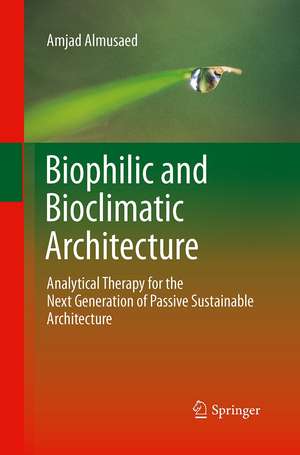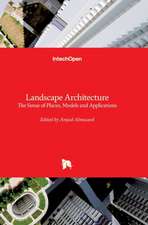Biophilic and Bioclimatic Architecture: Analytical Therapy for the Next Generation of Passive Sustainable Architecture
Autor Amjad Almusaeden Limba Engleză Paperback – 25 sep 2014
Biophilic and Bioclimatic Architecture has three parts:
• Part I focuses on the relationship between architecture and human needs and the creation process, demonstrating the meaning of architectural value in architectural hypothesis.
• Part II opens the way towards a new understanding of biophilic architecture as a response to the negative actions of humans and the negative effects of using natural resources.
• Part III shows the benefits of combining the effects of the climate with the notion of human comfort in bioclimatic architecture.
| Toate formatele și edițiile | Preț | Express |
|---|---|---|
| Paperback (1) | 1153.29 lei 38-44 zile | |
| SPRINGER LONDON – 25 sep 2014 | 1153.29 lei 38-44 zile | |
| Hardback (1) | 1427.91 lei 6-8 săpt. | |
| SPRINGER LONDON – 24 dec 2010 | 1427.91 lei 6-8 săpt. |
Preț: 1153.29 lei
Preț vechi: 1517.49 lei
-24% Nou
Puncte Express: 1730
Preț estimativ în valută:
220.79€ • 230.37$ • 185.08£
220.79€ • 230.37$ • 185.08£
Carte tipărită la comandă
Livrare economică 08-14 martie
Preluare comenzi: 021 569.72.76
Specificații
ISBN-13: 9781447157267
ISBN-10: 1447157265
Pagini: 452
Ilustrații: XXIX, 422 p.
Dimensiuni: 155 x 235 x 24 mm
Greutate: 0.69 kg
Ediția:2011
Editura: SPRINGER LONDON
Colecția Springer
Locul publicării:London, United Kingdom
ISBN-10: 1447157265
Pagini: 452
Ilustrații: XXIX, 422 p.
Dimensiuni: 155 x 235 x 24 mm
Greutate: 0.69 kg
Ediția:2011
Editura: SPRINGER LONDON
Colecția Springer
Locul publicării:London, United Kingdom
Public țintă
ResearchDescriere
Biophilic and Bioclimatic Architecture is a guide to innovative architectural design for architects, engineers and other specialists who are working with biophilic and bioclimatic architectural concepts.
The concept of biophilic and bioclimatic architecture represents one of the most consistent concepts of sustainable building. By considering ecologically harmless materials and the use of renewable energy sources, it brings an enormous increase of quality in planning and workmanship, as well as comfortable living. This new movement aims to create environmentally friendly, energy-efficient buildings and developments by effectively managing natural resources. It merits a deeper exploration.
Biophilic and Bioclimatic Architecture has three parts:
• Part I focuses on the relationship between architecture and human needs and the creation process, demonstrating the meaning of architectural value in architectural hypothesis.
• Part II opens the way towards a new understanding of biophilic architecture as a response to the negative actions of humans and the negative effects of using natural resources.
• Part III shows the benefits of combining the effects of the climate with the notion of human comfort in bioclimatic architecture.
Climate change, environmental impact and declining natural resources are driving scientific research and novel technical solutions. Green Energy and Technology serves as a publishing platform for scientific and technological approaches to "green" - i.e., environmentally friendly and sustainable - technologies. While the main focus lies on energy and power supply, the series also covers green solutions in industrial engineering and engineering design. Green Energy and Technology is a monograph series addressing researchers, advanced students and technical consultants, as well as decision makers in industry and politics. The level presentation ranges from instructional to highly technical.
The concept of biophilic and bioclimatic architecture represents one of the most consistent concepts of sustainable building. By considering ecologically harmless materials and the use of renewable energy sources, it brings an enormous increase of quality in planning and workmanship, as well as comfortable living. This new movement aims to create environmentally friendly, energy-efficient buildings and developments by effectively managing natural resources. It merits a deeper exploration.
Biophilic and Bioclimatic Architecture has three parts:
• Part I focuses on the relationship between architecture and human needs and the creation process, demonstrating the meaning of architectural value in architectural hypothesis.
• Part II opens the way towards a new understanding of biophilic architecture as a response to the negative actions of humans and the negative effects of using natural resources.
• Part III shows the benefits of combining the effects of the climate with the notion of human comfort in bioclimatic architecture.
Climate change, environmental impact and declining natural resources are driving scientific research and novel technical solutions. Green Energy and Technology serves as a publishing platform for scientific and technological approaches to "green" - i.e., environmentally friendly and sustainable - technologies. While the main focus lies on energy and power supply, the series also covers green solutions in industrial engineering and engineering design. Green Energy and Technology is a monograph series addressing researchers, advanced students and technical consultants, as well as decision makers in industry and politics. The level presentation ranges from instructional to highly technical.
Cuprins
1. Overview.- 2. Architectural Hypothesis.- 3. Architectural Theory.- 4. Biophilic Architecture Hypothesis.- 5. Introduction on Plants and Vegetations.- 6. Introduction on Growing Media (Soil).- 7. Introduction on Irrigation Systems.- 8. Green Areas in Biophilic Architecture.- 9. Climate Change and Human Health (The Challenges and Remediation Act).- 10. The Urban Heat Island Phenomenon Effects Upon Urban Components.- 11. The Green Areas Benefits Upon Urban Sustainability Role.- 12. Plants, Oxygen and Human Life Benefits.- 13. Evapo-Transpiration and Environmental Ameliorate Benefits.- 14. Socio and Healthy Human Psychology Upon Biophilic Architecture.- 15. Green Roofs.- 16. Green Walls.- 17. Interaction Between Architectural Creation and Environmental Impact.- 18. Vernacular Architecture and Human Experiences.- 19. Vernacular Architecture from Hot Regions (Basrah - Iraq).- 20. Vernacular Architecture from Cold and Temperate Regions (Aarhus - Denmark).- 21. Improvement of Exterior and Interior Energy Allocate.- 22. Improvement of Thermal Insulation (Passive Buildings).- 23. Improvement of Energy Saving Concept.- 24. Windows Between Optical and the Thermal Roles.- 25. Illuminations by Sun-Skylight- Tubes.- 26. Illumination by Optical Arteries.- 27. Illuminate by Light Shelves.- 28. Cooling by Effective Shading.- 29. Cooling by Comfort Ventilation.- 30. Cooling by Direct Evaporative Systems.- 31. Cooling by Indirect Evaporative Systems.- 32. Cooling by Thermal Earth Inertia.- 33. Passive Heating Concept.- 34. Solar Passive Heating Components.- 35. Passive Heating Systems.- 36. Remembering Conclusion.
Notă biografică
Dr. Arch Amjad Almusaed holds a PhD degree in Architecture (Environmental Design) from “Ion Mincu” University, Bucharest, Romania.
Dr. Al-musaed has 20 years’ experience in passive, bioclimatic, and biophilic architecture with innovative orientation of architectural science. He has carried out a great deal of research and technical survey work, and has performed several studies, in the above areas.
He is an active member of many international architectural associations, such as the International Union of Architects, Green Roofs International, Passive and Low Energy Architecture, The City and Ecology, and ISR.
Dr. Al-musaed has 20 years’ experience in passive, bioclimatic, and biophilic architecture with innovative orientation of architectural science. He has carried out a great deal of research and technical survey work, and has performed several studies, in the above areas.
He is an active member of many international architectural associations, such as the International Union of Architects, Green Roofs International, Passive and Low Energy Architecture, The City and Ecology, and ISR.
Textul de pe ultima copertă
The concept of biophilic and bioclimatic architecture represents one of the most promising ideas in sustainable building. Together with its consideration of ecologically harmless materials and use of renewable energy sources, it brings an enormous quality increase in planning and workmanship, as well as an improvement in inhabitants’ comfort. This valuable concept merits a dedicated discussion.
Biophilic and Bioclimatic Architecture outlines a new movement that aims to create environmentally-friendly, energy-efficient buildings and developments by effectively managing natural resources. The book has three parts:
Biophilic and Bioclimatic Architecture outlines a new movement that aims to create environmentally-friendly, energy-efficient buildings and developments by effectively managing natural resources. The book has three parts:
- Part I focuses on the impact of human needs on the creation process and assesses the concept of value in architectural hypotheses.
- Part II opens the way to a new understanding of biophilic architecture as a response to destructive human activities and also considers the side effects of using natural resources.
- Part III shows the significant benefits of making the connection between climate and comfort that can be achieved through bioclimatic architecture.
Caracteristici
Develops an architectural strategy, which integrates the concepts of passive and low-energy buildings, biophilia and human comfort
Enables readers to develop a new understanding of biophilic architecture
Written by an expert on architecture
Includes supplementary material: sn.pub/extras
Enables readers to develop a new understanding of biophilic architecture
Written by an expert on architecture
Includes supplementary material: sn.pub/extras


